Cupra Tavascan
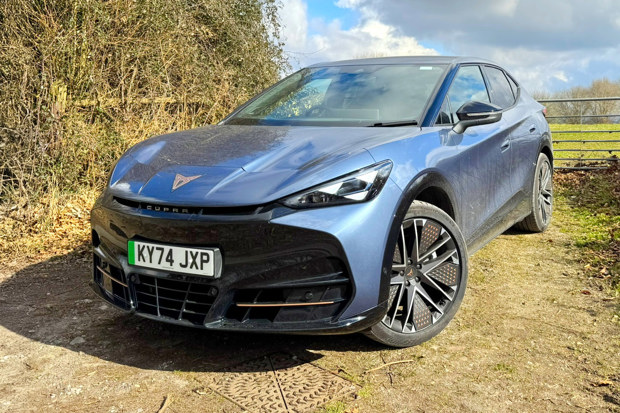
Cupra Tavascan VZ2
- Run by: Phill Tromans
- Price when new: £60,835
- Power: 340PS
- Torque: 545Nm
- Battery Capacity: 77kWh
- Claimed efficiency: 4.1 miles per kWh
- Range: 324 miles
- 0-62mph: 5.5 seconds
Report 1: Entering the Electric Age
We welcome the new Cupra Tavascan to the Honest John fleet for the next three months.
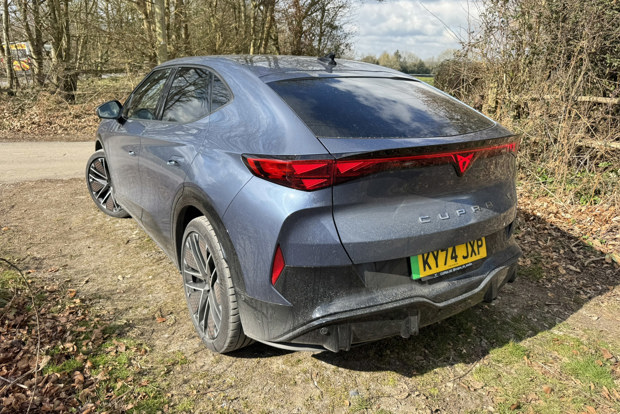
Date: 3 April 2025 | Current mileage: 2310 | Claimed economy: 4.1 miles/kWh | Actual economy: 2.9 miles/kWh
As part of my job, I’ve driven more electric cars than I can remember. But I’ve never actually lived with one. Usually, I’d be presented with a fully charged test car, head out for a few hours and then hand it back. Or I’d have it at home for a week and simply plug in the three-pin charger that came with the car in order to get more juice.
As a result, I know all about the instant response from the accelerator and the freedom from the traditional constraints that an electric platform gives designers. But I’m ashamed to admit that I’ve never used a public charger and never had to think about range anxiety. All my own cars and my previous long-term test vehicles, have used combustion engines, the foibles of which I’m well used to.
So it’s with no small sense of intrigue that I welcome my new family car for the next three months. This Cupra Tavascan had just 2000 miles when it arrived at my house and I’ve now had a few weeks to get acquainted with it.
I confess, it’s been rather exciting. And confusing. Whether we like it or not, the automotive world is going electric, so the journey I’m embarking on is one that others will have to take sooner or later. There are lots of things to get one’s head around.

But before all the infrastructure, however, let’s talk about the car. This is the top-of-the-line Tavascan in VZ2 trim, which means it comes with the more powerful twin-motor setup, with 340PS and 545Nm of torque, and all-wheel drive (AWD). The battery is a 77kWh unit and efficiency-wise, Cupra says it’ll do up to 3.5 miles per kWh used.
The colour? Tavascan Blue. Unoriginal, but accurate in name. It was a no-cost option – in fact, there are no options on my car at all, meaning it can be bought off the shelf for £60,835 at the time of writing. While the Tavascan is an all-wheel-drive SUV it’s got no off-road inclinations at all. In keeping with the Cupra brand, it’s a sporty number with the aim of slapping a smile on your face when you’re behind the wheel.
All that power and instant torque will certainly help that, with an official 0-62mph time of 5.5 seconds despite its hefty weight – 2267kg in this AWD form. In my short time with the car so far I can confirm that it does indeed feel quick, with all the torque available as soon as your feet touch the pedal. There are various setup modes to play with to imbue the Tavascan with different characters, including the everything-to-11 Cupra mode, and I look forward to playing with them.
While it’s in my care, I’m aiming to have the Tavascan take over day-to-day family duties from our 2018 Seat Leon ST estate. Early signs are promising – the 540-litre boot, with an electric tailgate, is capacious and has easily held a child's scooter, bags and various other accoutrements for a day out over a weekend. There’s loads of rear legroom and it was easy to install a child seat using the Isofix mounting points.
Report 2: My friend electric
A month and many miles into my electric car ownership(ish) experience, and it’s been educational.
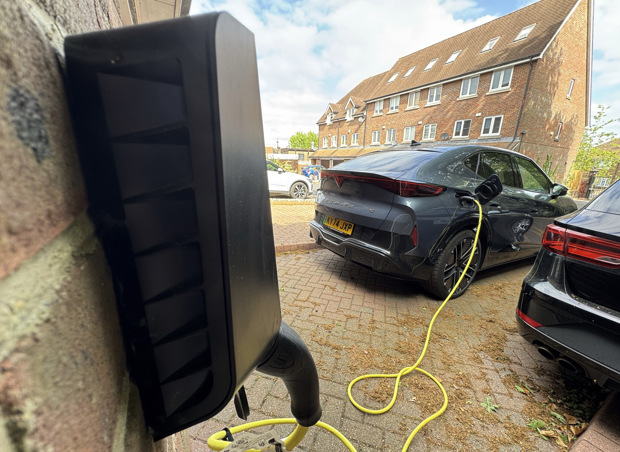
Date: 14 April 2025 | Current mileage: 4251 | Claimed economy: 4.1 miles/kWh | Actual economy: 2.8 miles/kW/h
A month and many miles into my electric car ownership(ish) experience, and it’s been educational. My wife and I use the Tavascan daily, including jaunts from our home in Sussex to Somerset, Birmingham, Leicestershire and beyond.
It’s been something of a baptism of fire when it comes to understanding the intricacies of charging, but I’m pleased to report that it’s been almost universally positive.
Home on the (battery) range
Before we get to the car itself, a few words on infrastructure – something that, as a relative electric noob, I was somewhat wary of. I’ll begin with a warning – be very careful when using a three-pin charger. In my ignorance, I had mine plugged into an extension cable – one suitable for EVs – but had forgotten that it was run through another, much less robust extension (a legacy of it being used to power my electric garage door).
A couple of weeks in, I smelled burning plastic in the garage. The plug had overheated and melted the less extension socket, which was not built for such heavy duty. Eek. Disaster averted, though through luck rather than judgement.
Thankfully, my new dedicated EV charger arrived soon afterwards. The process of installation of my new Easee One was painless – a very friendly electrician arrived at 8am, and three hours later he’d added an extra consumer unit to my existing fuse box, run a wire through the garage wall and mounted the charger by my front door. A quick setup with the smartphone app, into which I popped the details of my tariff, and we were away.
It’s easy to use: plug in, and charge. Had I a tariff that gave me cheaper electricity overnight, I could program the app to only charge at those off-peak times. However, as I’ve only got the car for a few months, I decided against changing my tariff for now.
(A side note: it turns out that EV-specific tariffs often require your car to be on the provider’s approved list to get the preferential rate. The Tavascan wasn’t on the lists – perhaps because it’s pretty new. The cheap electricity is for EVs and EVs only, and if the supplier can’t confirm that you’re charging the car rather than, say, running the washing machine, it won’t sign you up. Worth noting for future reference.)
Fast charging
Home charging’s been great – park, plug in, done. No need for petrol station trips, and no range anxiety for local drives.
Longer trips take a bit more planning, however. I’ve now used quite a few public fast chargers, and while it’s more of a faff than just stopping at the first fuel station I see, it hasn’t really been much of a problem.
The trickiest charge was the first one. After a trip up to Worcestershire, which the Tavascan managed on a single charge, I needed to charge overnight. Luckily my hotel had a BP Pulse rapid charger nearby. “Great,” I thought, “I can just leave it there overnight.” Not so. As it turns out, the fastest chargers will pile on extra charges if you’re plugged in for more than 90 minutes, in order to stop people hogging them. So I had to get up an hour early, plug the car in and go for a 7am coffee in order to have a full battery in time for the day ahead.
At other times though, I’ve just spent a couple of minutes planning each journey to make sure there’s a charger somewhere en route – and there always has been. I’ve tended to favour the larger multi-charger hubs to minimise the chances of a queue, but there have been numerous sites of all sizes to choose from. Google Maps lets you plot your route and will tell you what chargers are on the way, while Waze will do similar. The Tavascan’s own navigation system will also do it, but… well, Waze and Google Maps are better navigation systems overall.
Initially, I found it a chore to sign up for various providers apps in order to get the best price per kW, but have since discovered the Electroverse app, which consolidates access to many networks via a single app and RFID card. So far it’s worked on every fast charger I’ve tried. Easy.
With the Tavascan’s battery range well above 200 miles, and closer to 250 when it’s warm, I never have to worry about short journeys, and longer charges rarely take more than 20-30 minutes – just long enough for coffee and cake.

And the car?
There’s a lot to like about the Tavascan, and with a couple of thousand miles behind me, I feel like I know it well.
As a family car, it’s been very good. My five-year-old has loads of space in the back, and the boot’s is a decent size, and the hands-free electric boot lid works 90% of the time when you waggle your foot under the rear bumper (which is considerably better than most similar systems). Very useful when you’ve got your arms full.
The panoramic roof floods the interior with light, making it feel nice and airy even when cruising slowly through M25 traffic. Heated front seats and steering wheel have been a godsend on chilly mornings, and the recent warmer weather has seen my wife and I luxuriate in the ventilated function, too, with cold air blown onto sweaty backs.
Storage could be better. The funky F1-style halo design between the front seats looks great, but it takes up a lot of space where storage could be. There’s a wireless phone charger, a pair of cupholders and a tiny tray, and that’s it. Sure, the chilled armrest cubby is great (and huge), but there’s a load of unused capacity that, on longer trips, would be useful for odds and sods.
The bucket-style sporty seats are very comfortable, and the memory adjustment function has been useful for the easy swapping of drivers. There are no seat-back pockets for my daughter, though at least the wipe-clean material handles her muddy feet kicking them (despite orders to stop).
As expected of a Cupra, the Tavascan is fun to drive. All-wheel drive and 340PS means none-too-shabby acceleration, delivered with the instant zing inherent in electric drivetrains, despite its considerable weight. I noted when I first drove the Tavascan some months ago that the brakes felt inconsistent in their application, and that’s the same on this car too, although I have got used to its weird habit of needing extra pressure on the pedal as you slow down.
The ride, firm enough for solid cornering ability, is supple enough not to elicit complaints from passengers. Long journeys have passed in a very relaxing way, largely thanks to the decent Sennheiser sound system and the adaptive cruise control, which is a considerable mercy in stop-start motorway traffic.
Overall? A very good start – here’s hoping it continues.
Report 3: Closer to home
The Tavascan did itself proud during a cluster of more local journeys, but interior annoyances remain
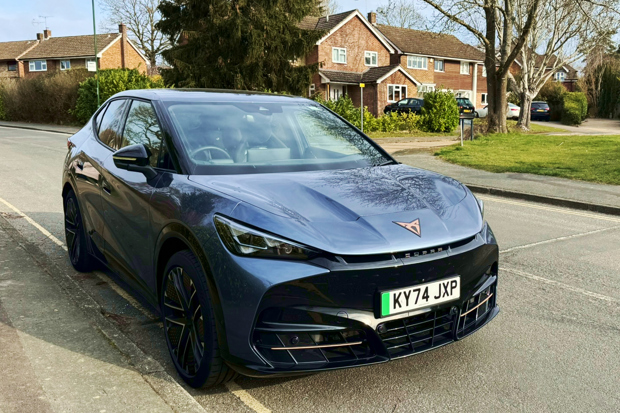
Date: 23 June 2025 | Current mileage: 5425 | Claimed economy: 4.1 miles/kWh | Actual economy: 3.2 miles/kWh
After about six weeks of big, long trips, the driving in my Tavascan has been much closer to base lately, and that’s where electric car ownership is really starting to make sense. With no lengthy drives that require a lengthy charging session, the small-to-medium-size jaunts have been as easy as easy can be. And cheap, too.
The only fly in the charging ointment thus far has been that rapid charging away from home still takes much longer than filling up with petrol or diesel, and costs far more than topping up via my newly installed Easee One home charger (although it’s still cheaper than fuelling up in the traditional manner).
However, with the last few weeks’ driving restricted largely to the school run, a variety of leisure centres and a 90-minute-each-way blast to see the Mary Rose in Portsmouth, I’ve not had to touch a fast charger. By simply plugging in the car on the driveway when I get home, it’s got a full battery whenever I need to use it and, in the warmer weather, a predicted range of around 270 miles that’s proved pretty accurate in the real world.
Part of that extended predicted range could also be because I’ve been getting better efficiency, thanks to the inherent EV trait of being more efficient with start-stop driving. Contrary to conventional combustion guidance, which would have you sit at around 56mph to get the best miles per gallon, EVs thrive on regular braking in order to regenerate the battery, so bimbling around slowly gets you better miles per kWh (the electric MPG equivalent).

Thanks to the Easee app, into which I’ve plumbed our electricity tariff information, I know that I spent £103.91 keeping the car charged over the past month, which would equal just under two tanks of fuel in my personal car, a petrol-powered SEAT Leon estate, giving a range of about 700 miles. During that time, I’ve done around 1200 miles in the Tavascan, which is both larger and heavier, with more power (340PS vs 180PS) and four-wheel drive. I’d say that’s a substantial financial win.
I’ve been discovering more about the car itself, too. After the initial honeymoon, there are a few things that irk me, which hopefully can be addressed in a mid-life facelift. The lack of front-seat storage continues to be annoying, and the halo-like central sculpture that wowed me when I first got into the Tavascan now just continues to remind me that I’ve got nowhere to throw sunglasses or a wallet.
The industry-wide obsession with touch-sensitive tech continues to blight previously simple tasks, too. Rather than having two sets of electric window toggles on the driver’s side – one set for the front windows, one set for the back – the Cupra has just a single pair, with a touch-sensitive button labelled REAR to switch between the two. And every single time I’ve gone to lower the front window to grab a ticket at a car park or speak to someone, I’ve inadvertently brushed the button and promptly lowered the back window. It’s maddening. Even a normal REAR push switch would be better, because I could tell by touch if I’d pressed it – with a touch-sensitive setup, I don’t realise until a draft hits my neck from behind.

The same is true on the steering wheel, which is infested with touch-sensitive surfaces for all manner of controls. In fairness, some features are quite cool; the cruise control up-down buttons, for example, can be pressed to increase or decrease the speed by 1mph, or swiped to change the increments to 5mph.
But I’m forever brushing the volume and display adjustment buttons by mistake, thanks to their location millimetres from my hands on the wheel. Normal buttons would require pressure to activate them, but the merest breath of unintended presence cranks the volume up or fiddles with the dash settings. Get rid, please.
For all those minor rants, I’m still very much enjoying my time in the Tavascan. Its considerable oomph is both useful for getting up to speed on the motorway and for entertaining my five-year-old daughter, who keeps asking “Daddy, can we do the rocket boost?”. It’s both practical and fun to drive on local winding roads, and I’ve just about got used to the idiosyncratic braking, as long as the regeneration levels are kept high to replicate engine braking. Still, that’s something else for the Cupra facelift engineers to have a look at.
On top of the enjoyment from inside the car, I’ve noticed several people cast admiring glances at it as we drive by, and it’s rare on the roads, too – I’ve only seen two others, and one of those was another press car. It’s certainly something a bit different from the somewhat anonymous Audi Q4 E-trons and Volkswagen ID.4s that are basically ten a penny, and it’s always nice for would-be customers to have a solid, left-field choice.
Report 4: Goodbyeeee
It's time to say goodbye to the Cupra Tavascan, which has influenced my next car purchase
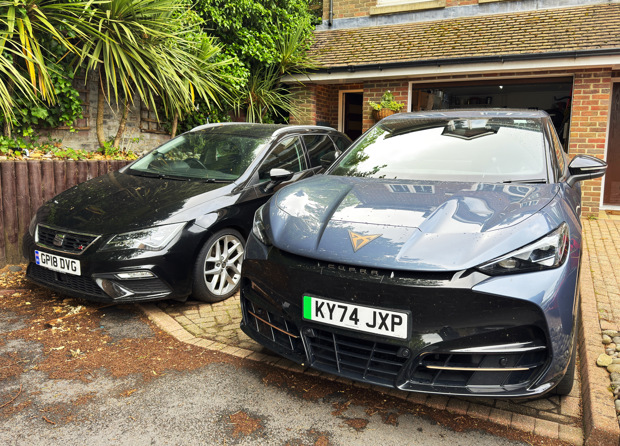
Date: 10 July 2025 | Current mileage: 5812 | Claimed economy: 4.1 miles/kWh | Actual economy: 2.9 miles/kWh
Three months with the Cupra Tavascan have absolutely flown by, and now it’s time for it to leave my possession. First things first – yes, I’ll miss it. It’s by no means perfect, as I’ll expand on below, but it is a Very Good Car, and has almost entirely allayed my fears of electric car ownership in 2025.
During my three months, I’ve covered far more miles than I expected to, thanks to some family outings and some long-range work trips – 3894 miles, to be exact, which has equated to around 121 (and a half) hours behind the wheel. I went into the experience with some trepidation, having driven numerous electric cars but never actually lived with one for any real length of time. How would home charging work, I wondered. What’s the deal with fast-charging on longer trips? Basically, is this viable for my life in a small town?
(Spoilers: Yes.)
Going electric
My early nerves about charging weren’t helped when I nearly burned my house down using the three-pin charger with an entirely unsuitable extension (entirely my fault, not the car’s), but the installation of an Easee One charger soon fixed that. Plugging in soon became as much of an everyday routine as parking and locking the door on my driveway, and I always had a full battery the following morning. Range anxiety? If anything, not having to remember to go to the petrol station made me even more confident.
Longer journeys took a bit more adjustment, but through a combination of the Electroverse card and app, plus a small amount of route planning, it was far less of a faff than I anticipated. Soon, it became just another thing you do when going on a longer journey, like making sure you’ve brought car snacks or packed your toothbrush.

Though I’ve heard other EV owners wail about the infrastructure – chargers not working or being too busy – I’ve had to have any real issues. A couple of times, I had to lock and unlock the car to get the charger to ‘talk’ to the Cupra, but that’s been about it. And by prioritising larger charging hubs on my journeys, I’ve always found a free charger quickly.
Cupra-duper
So, the electric concept has been a hit. But what of the Cupra Tavascan itself? My review is largely positive. It’s largely practical, with a big cabin, a large boot, and plenty of space for a child seat. I loved the panoramic roof bathing the interior with light, and the ventilated seats have been great during hot weather.
I’m less of a fan of the lack of cabin storage solutions, the finicky and unreliable touch-sensitive controls and the INFURIATING window switches (one pair has to be switched between controlling the front and rear windows), but they’re minor quibbles. I also like the fact that I’ve barely seen another Tavascan on the road, and that I see quite a few passers-by turning their heads to check out its curves. It has considerable kerb appeal.
It’s fun to drive, too – my daughter will miss the ‘rocket boost’ oomph of the dual-motors and their 340 horses, and the Cupra’s sporty character has been well-balanced for comfort. It’s especially comfortable on long, boring journeys thanks to the adaptive cruise control and the excellent sound system.
There’s room for refinement on the braking quirks, but I did get used to it. The Matrix LED headlights need a bit of fine-tuning too – they’re great in theory (and I’ve loved them in other cars), but judging by the number of irate flashes I’ve had from oncoming traffic, they’re too slow to react. I turned the feature off and went back to manual high beam operation.
I have very little to say about the car’s infotainment system, as I found myself using wireless Apple CarPlay 99% of the time and never felt like I was missing anything. I did enjoy fiddling with the in-car lighting effects, however, which look slick at night.

I ended the loan with an average efficiency of 2.9 miles/kWh, which is down on the claimed 4.1m/kWh. I think there are two main reasons for this – quite a lot of motorway miles, where electric cars are less efficient than around town, and also that darned acceleration, which is somewhat moreish. I have undoubtedly been guilty of mashing the accelerator for fun and burning through battery charge. With a lighter foot and more around-town driving, that efficiency number would soon rise.
So, would I recommend the Cupra Tavascan? Yes, with caveats. It’s stylish, fun to drive, and practical, but let down slightly by fiddly controls and a lack of storage. If you’ve got home charging, though, it’s a convincing package.
The future
Since the Tavascan loan ended, I’ve been running the numbers on whether it’s worth keeping my petrol-powered SEAT Leon or replacing it with a new (leased) electric car. I compared the running costs in terms of fuel, maintenance and likely depreciation on a seven-year petrol car, and compared them to a new lease, and whatever way I cut it, the electric car argument won out – the monthly leasing costs are higher than the loan I was repaying on the SEAT, but the low running costs (plus the appeal of a much newer, more comfortable car) more than make up for it.
And so, I’ve put in an order for a Skoda Enyaq and will be selling the Leon. I’ve also adjusted my home electricity tariff to lower my charging costs – instead of 27p per kWh, I’ll soon be paying just 7p for EV charging, which should make some big savings.
I’ll always be a petrolhead, but when it comes to running a family car, I’m a firm electric convert. For me, going to battery power isn’t just possible, it’s now positively preferable.
